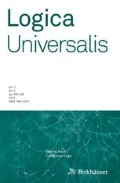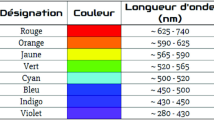Abstract
In this paper evidence will be provided that Wittgenstein’s intuition about the logic of colour relations is to be taken near-literally. Starting from the Aristotelian oppositions between propositions as represented in the logical square of oppositions on the one hand and oppositions between primary and secondary colors as represented in an octahedron on the other, it will be shown algebraically how definitions for the former carry over to the realm of colour categories and describe very precisely the relations obtaining between the known primary and secondary colours. Linguistic evidence for the reality of the resulting isomorphism will be provided. For example, the vertices that resist natural single-item lexicalization in logic (such as the O-corner, for which there is no natural lexicalization *nall (=not all)) are not naturally lexicalized in the realm of colour terms either. From the perspective of the architecture of cognition, the isomorphism suggests that the foundations of logical oppositions and negation may well be much more deeply rooted in the physiological structure of human cognition than is standardly assumed.
Similar content being viewed by others
References
Berlin B., Kay P.: Basic Color Terms Their Universality and Evolution. University of Los Angeles Press, Berkeley (1969)
Blanché R.: Sur l’opposition des concepts. Theoria 19, 89–130 (1953)
Blanché R.: Structures intellectuelles Essai sur l’organisation systématique des concepts. Vrin, Paris (1969)
Da Vinci, L.: A treatise on painting, transl. J.F. Rigaud. J. Taylor, London, 1802 edn., (1651)
Dominy N., Lucas P.: Ecological importance of trichromatic vision to primates. Nature 410, 363–366 (2001)
Franklin, J.: Diagrammatic reasoning and modelling in the imagination: the secret weapons of the scientific revolution. In: 1543 and All That: Image and Word, Change and Continuity in the Proto-Scientific Revolution, pp. 53–115. Dordrecht (1999)
Goethe J.V.: Theory of Colours 1840 edn. John Murray, London (1810)
Horn, L.: A Natural History of Negation. The University of Chicago Press, Chicago (1989)
Jacobs G.: Evolution of color vision in mammals. Philos. Trans. R. Soc 364, 2957–2967 (2009)
Jacobs G.: Variations in primate color vision: mechanisms and utility. Evol. Anthropol 3, 196–205 (2009)
Jaspers, D.: Operators in the Lexicon—on the negative logic of natural language. LOT Dissertation Series, vol. 117. Utrecht Institute of Linguistics/LOT Netherlands Graduate School of Linguistics, Utrecht (2005)
Londey D.C.J.: Apuleius and the square of opposition. Phronesis 29(2), 165–173 (1984)
Peirce, C.: Chapter A Boolean algebra with one constant. In: Writings of Charles S. Peirce, A Chronological Edition, 1989 edn., vol. 4, pp. 218–221. Indiana University Press, Indiana (1880)
Schopenhauer, A.: On Vision and Colors, An Essay, Ueber Das Sehn Und Die Farben: Eine Abhandlung, 1994 edn. Berg, Oxford (1816)
Seuren, P.: Language from within. The Logic of Language, vol. 2. Oxford University Press, Oxford (2010)
Smessaert H.: On the 3d visualisation of logical relations. Logic. Univ. 3, 303–332 (2009)
Trier, J.: Der deutsche Wortschatz im Sinnbezirk des Verstandes: Die Geschichte eines sprachlichen Feldes, vol. I. Von den Anfängen bis zum Beginn des 13. Jhdts. Winter (1931)
Wittgenstein L.: Remarks on Colour. Basil Blackwell, Oxford (1977)
Author information
Authors and Affiliations
Corresponding author
Additional information
To Nancy and Sylvain Bromberger
This work was completed with the most appreciated assistance of Lorenz Demey, Koen Roelandt and Hans Smessaert. It has also benefited considerably from a joint talk with Richard Larson at the Georgetown Workshop on the Evolution of Human Cognition (March 18 2011), and from numerous fruitful discussions with Pieter Seuren, Larry Horn, Richard Larson, Guglielmo Cinque, Hans Smessaert, Jeroen van Craenenbroeck, Guido vanden Wyngaerd, Johan Rooryck, Alessio Moretti and Fabien Chang. I also thank several participants of the Second World Conference on the Square of Oppositions, MIT LingLunch, The Proper Use of Quantifiers in Ordinary Language workshop (Ljubljana), the Syntax Circle (Meertens Institute Amsterdam).
Rights and permissions
About this article
Cite this article
Jaspers, D. Logic and Colour. Log. Univers. 6, 227–248 (2012). https://doi.org/10.1007/s11787-012-0044-y
Received:
Accepted:
Published:
Issue Date:
DOI: https://doi.org/10.1007/s11787-012-0044-y




